
Module on Ethnic Studies Key Terms and Origins. Module can be used for introduction level Ethnic Studies course.
- Subject:
- Ethnic Studies
- Material Type:
- Homework/Assignment
- Lecture
- Module
- Textbook
- Author:
- Andres Rodriguez
- Date Added:
- 12/12/2023

Module on Ethnic Studies Key Terms and Origins. Module can be used for introduction level Ethnic Studies course.

This book is written by students in an Integrated Basic Education Skills and Training (I-BEST) class at Lake Washington Institute of Technology. Jessica Dunker and Paul Redman, instructors, have contextualized the reading, writing and classroom activities for this course around topics related to diversity and ethnic studies. This Pressbook is a reflection of the work our students have made in writing as well as gaining a better understanding of themselves and each other.
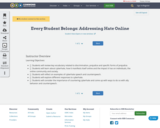
Learning Objectives: Students will review key vocabulary related to discrimination, prejudice and specific forms of prejudice. Students will learn about cyberhate, how it manifests itself online and the impact it has on individuals, the online community and society. Students will reflect on examples of cyberhate speech and counterspeech. Students will explore different responses to cyberhate. Students will consider the importance of countering cyberhate and come up with ways to do so with ally behavior and counterspeech.
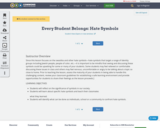
Since this lesson focuses on the swastika and other hate symbols—hate symbols that target a range of identity groups including Jewish people, people of color, etc.—it is important to be mindful that seeing and discussing these symbols could be upsetting for some or many of your students. Some students may feel relieved or comfortable discussing these issues in class and others may feel nervous, uncomfortable or angry to be talking about a topic so close to home. Prior to teaching the lesson, assess the maturity of your students in being able to handle this challenging content, review your classroom guidelines for establishing a safe learning environment and provide opportunities for students to share their feelings as the lesson proceeds.]LEARNING OBJECTIVESStudents will reflect on the significance of symbols in our society.Students will learn about specific hate symbols and teach their classmateswhat they learned.Students will identify what can be done as individuals, school or a community to confront hate symbols.
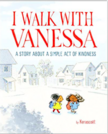
This lesson utilizes the wordless picture book I Walk With Vanessa: A Story About a Simple Act of Kindness. After a whole-class read-aloud, students divide into groups to create dialogues for specific scenes in the book. The activity encourages students to discuss why people choose different roles in a situation allowing collaborative problem solving and practicing how to care for and protect others. The optional fourth and fifth-grade student extension includes analyzing historical examples and discussing why and how people have failed to protect others and how we can be better allies to those being harmed in our communities today.

Lesson ObjectivesStudents will be able to articulate what microaggressions are and how they transpire.Students will analyze how words can shift meaning in different contexts and explain how and why communication crosses from harmless to harmful.Students will examine microaggressions from multiple perspectives to compare and contrast how different people might respond.Students will generate solutions and practice responding to microaggressions.
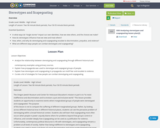
Grade Level: Middle - High SchoolLength of Lesson: Two 90 minute block periods, Four 50-55 minute block periodsEssential QuestionsIn what ways do “single stories” impact our own identities, how we view others, and the choices we make?How do stereotypes influence how we view and treat others?How, when, and why do stereotyping and scapegoating escalate to discrimination, prejudice, and violence?What are different ways people can combat stereotypes and scapegoating?
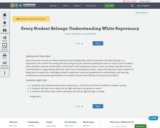
Since this lesson focuses on white supremacy which targets Jews, African Americans and other groups, it is important to be mindful that seeing and discussing the topic could be upsetting for some or many of your students. Some students may feel comfortable or interested in discussing these issues in class and others may feel nervous, uncomfortable or angry talking about this topic. Prior to teaching the lesson, assess the maturity of your students in being able to handle this challenging content, review your classroom guidelines for establishing a safe learning environment and provide opportunities for students to share their feelings as the lesson proceeds.]LEARNING OBJECTIVES Students will understand what white supremacy is, its history and how it manifests in modern society. Students will learn more about the alt right and how it has grown in recent Students will reflect upon white supremacy and the alt right through a writingassignment.

Examine identity and assimilation with an activity that asks the essential question: Was there ever a part of your identity you had to hide?
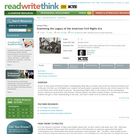
As part of their study of Richard Wright's "Black Boy", students research and reflect on the current black-white racial divide in America. By examining the work of literature in the context of contemporary events, students will deepen their understanding of the work and of what it means to be an American today.
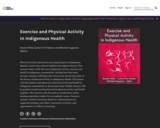
Short Description:
Physical activity and exercise are integral parts of Indigenous identity, woven into cultural tradition throughout history. This resource aims to tell the story of physical activity, exercise, and health in Indigenous communities. Divided into four main sections, learners will begin their journey by uncovering some of the history of physical activity in Indigenous health. The learner will then explore and appreciate physical activity and health in Indigenous communities at the present time. Finally, learners will be guided towards moving forward in physical activity and health together. This resource may be used as a stand-alone online learning experience and/or for an academic course. Features include: wholistic learning objectives, informational text, suggested readings and videos, interactive activities, and opportunities to reflect on learning.
Long Description:
Physical activity and exercise are integral parts of Indigenous identity, woven into cultural tradition throughout history. Traditional games hold not only physical purpose, but also spiritual, cultural, and practical roles. The Wholistic Model (a balance of physical, cultural, intellectual-emotional, and spiritual well-being) is applied via physical activity to help develop the individual. This is important to how physical activity and individual development is approached in Indigenous communities. While there is a long history of Indigenous participation and achievement in physical activity, there is an equally long history of exclusion. Indigenous peoples have different lived experiences of physical activity, including a history of systemic and overt forms of discrimination, as well as resurgence.
This resource aims to tell the story of physical activity, exercise, and health in Indigenous communities, and helps to address the Canadian national call to action for Truth and Reconciliation by providing an open access educational resource that may serve as one step in decolonizing physical activity in the post-secondary student community.
Features of this resource, which may be used as a stand-alone resource and/or for an academic course, include: suggested course framework, wholistic learning objectives, and content that may be used in lectures presented as informational text, suggested readings and videos to augment learning. As well, this resource includes a variety of interactive activities for students such as warm-up and cool-down activities, and opportunities for students to record and reflect on their learning.
Word Count: 24652
(Note: This resource's metadata has been created automatically by reformatting and/or combining the information that the author initially provided as part of a bulk import process.)

Imagine trying to cut your hair without metal tools. How would you do it? Join JPPM's Educator Nate Salzman as he uses experimental archaeology to answer the question "How did Native Americans cut their hair before metal tools?" Use to support the Maryland Social Studies Framework for grades 3, 4, and High School. To support the grade 3 content topic "Cultural Change Over Time," have students compare the advantages/disadvantages of the results of this experiment and how they receive a hair cut; for grade 4 topic "Native Cultures," have students either hypothesize and research how Native American tribes who did not have access to shells may have cut their hair or respond to the prompt "why did European colonists use metal tools for cutting their hair while the Native Americans used shells? Would some hair styles be easier to cut with one type of tool than the other?"; finally for HS topic "Exploration, Colonization, and Global Interaction, have students respond to the prompt "with the introduction of metal tools, how might the role of 'barber' have changed within a Native American tribe? If you evaluate or use this resource, consider responding to this short (4 question) survey at bit.ly/3G6RxUa
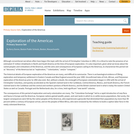
This collection uses primary sources to explore early exploration of the Americas. Digital Public Library of America Primary Source Sets are designed to help students develop their critical thinking skills and draw diverse material from libraries, archives, and museums across the United States. Each set includes an overview, ten to fifteen primary sources, links to related resources, and a teaching guide. These sets were created and reviewed by the teachers on the DPLA's Education Advisory Committee.
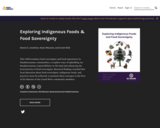
Short Description:
This OER examines food sovereignty and food experiences in Haudenosaunee communities, to explore ways of upholding our Haudenosaunee responsibilities to the land and enhancing the local practice of food sovereignty. Research findings revealed that local education about food sovereignty, Indigenous foods, and practices must be achieved, to promote these concepts in the lives of Six Nations of the Grand River community members.
Long Description:
Our research, based in Six Nations of the Grand River, examines food sovereignty and food experiences in Haudenosaunee communities, to explore ways of upholding our Haudenosaunee responsibilities to the land and enhancing the local practice of food sovereignty. The goal is to increase the access to and transmission of knowledge, so that more people to engage in food sovereignty. Haudenosaunee peoples with traditional knowledge, extensive community experience, and interests in food and culture were interviewed. Additionally, community members were surveyed to further understand what the needs of community are and what the community wishes to know about traditional foods and food sovereignty, in order to achieve a wholesome understanding and application of our ancestral knowledge. Interviews were audio recorded, transcribed, and analyzed. Analysis characterized knowledge and knowledge transmission, community, sharing, self-determination, access to traditional foods, co-existence with the natural world, connection to culture and identity, health, and food systems. These are all interwoven pieces that make up food sovereignty. Our findings produced the overall recommendation that local education about food sovereignty, Indigenous foods, and practices must be achieved, to promote these concepts in the lives of Six Nations members.
Keywords: Indigenous foods, food sovereignty, traditional knowledge, traditional foods, sustainable self-determination, food systems.
Word Count: 6223
ISBN: 978-0-9939046-0-8
(Note: This resource's metadata has been created automatically by reformatting and/or combining the information that the author initially provided as part of a bulk import process.)

Long Description:
The fundamental knowledge of understanding culture and teaching children from diverse backgrounds. Examination of the nature and function of culture, development of individual and group cultural identity, definitions and implications of diversity, and the influences of culture on learning, development, and pedagogy. This course has a required field experience component.
Word Count: 13196
(Note: This resource's metadata has been created automatically as part of a bulk import process by reformatting and/or combining the information that the author initially provided. As a result, there may be errors in formatting.)
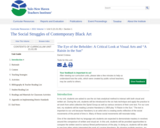
In this unit, students are asked to use the six hats analytical method to interact with both visual and written art. During the unit, students will be introduced to the six hats technique and apply the practice to art work from artist collective the Spiral Group as well as various versions of their core text. For our core text, my students will be reading Lorraine Hansberry’s 1959 play “A Raisin in the Sun.” The text is important to our unit because Hansberry is an artist who is creating works reflective of the social movements of the period of time in. Many of these social movements still resonate today.
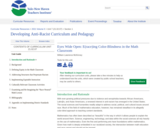
The focus of this curricular unit is twofold. The first is to consider the math classroom as a racialized space. In doing so, the unit will shed light on why math education is not race-neutral and will explain how color-blindness reinforces the oppression of students of color. The unit will examine how color-blindness within mathematics education ignores historical data and blames academic failure on students, their families, and their communities without recognizing the systemic biases that reproduce racial inequality through material stratification, deficiency framing, and reduced access to high quality instruction.
The second part of the unit will consider anti-racist teacher-centered instructional strategies that directly address inequality in math instruction. Among these strategies, the unit will consider teaching for understanding, group participation through complex instruction, culturally relevant pedagogy, and teaching mathematics for social justice. To achieve this, the unit will provide several examples of activities that approach mathematics instruction from a culturally relevant and critical lens. Then, the unit will examine a brief race-neutral Calculus lesson on integral approximation and will highlight components that reinforce systemic racism. Finally, the unit will then address what changes must be made within the sample lesson to better address issues pertaining to race in the math classroom.

Embedding Indigenous pedagogy into the online space
Long Description:
This project is a collection of resources for educators and instructors within the K-12 and post-secondary systems to support the adoption of Indigenous pedagogies in online learning environments. The 5R’s of Indigenous pedagogy are relationship, respect, relevance, responsibility, and reciprocity. These 5R’s serve as important reminders for course designers in K-12 and post-secondary educators and benefit all learners. Our resources and reflections address how the 5R’s of Indigenous education and research can be used as best practice to enrich online teaching platforms and remote learning. The positive effect of reciprocal communication, relationship building, and embracing Indigenous knowledge pedagogies in online learning environments extends out into the community and beyond.
Word Count: 13002
(Note: This resource's metadata has been created automatically by reformatting and/or combining the information that the author initially provided as part of a bulk import process.)

Short Description:
Continued outcome disparities for historically underserved student populations point to the urgent need for educators to critically examine structural inequities in higher education and shift current practices for greater equity in learning environments. This resource provides a structure for faculty to self-evaluate their teaching, identify evidence-based practices that can bring greater equity to their classrooms, and develop an Action Plan for implementing and evaluating those practices. By focusing on "just one thing," educators can develop a personalized, discipline-specific approach to continual improvement in enhancing equity for students.
Long Description:
The need for greater equity in higher education learning environments is abundantly clear, both nationally and in the state of Minnesota.[1] Yet many educators find themselves daunted by the enormity of the challenge. How exactly do we “do equity” in our classrooms, whether in person or online? While Diversity, Equity, and Inclusion (DEI) trainings abound, it can be difficult to translate broad concepts into concrete applications and practices within our respective disciplines.
In this Faculty Learning Community, we bring together a community of peers within your discipline to help you develop “just one thing” you can bring into your teaching practices to enhance equity for your students. Research around culturally responsive teaching—one of many terms used to indicate equitable teaching practices—boils down to three key areas. There are many different frameworks that have been used to describe those areas (see Transactional Distance Theory,[2] Community of Inquiry,[3] and the Rigor/Relevance Framework,[4] among others), but for our community, we will use these terms: Relationships: creating trust and community, in a manner that ensures all students know they and their cultures are valued assets to a collaborative and safe learning environment Relevance: establishing the connection between the learning content and students’ daily lives, cultural practices, and aspirations Rigor: well-designed, disciplinarily-current, and learning-science-informed courses, instruction, and assessment
Starting from this framework, you will develop an Action Plan. Progressing alongside your colleagues and benefitting from their insights, you will move from identifying a goal, to choosing “just one thing” that you can do toward achieving that goal, to planning incremental and time-bound steps for implementation, to determining how you’ll evaluate the plan’s effectiveness. While achieving “just one thing” can make a significant difference for students, our hope is that this initial practice will also offer you insights into what works best—not just for your students, but also for you as you continue to bring future equitable teaching practices into your learning environments.
Word Count: 10750
(Note: This resource's metadata has been created automatically by reformatting and/or combining the information that the author initially provided as part of a bulk import process.)

This is a project for the play Fences by August Wilson.